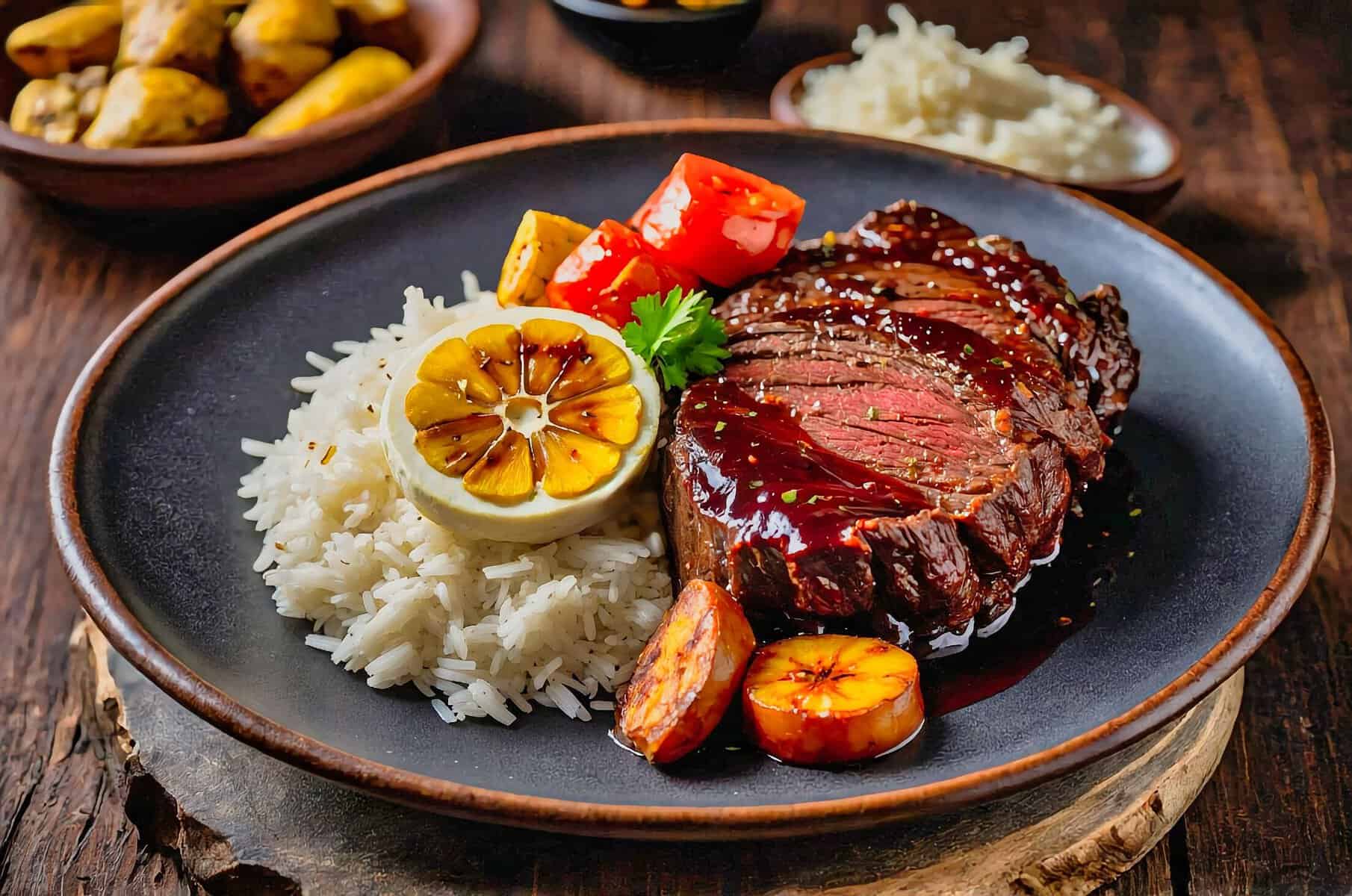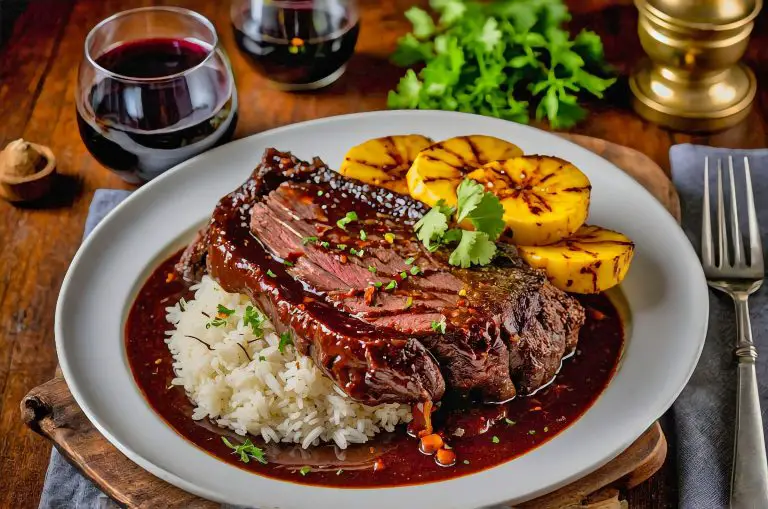Venezuela Asado Negro Recipe
The Venezuela Asado Negro recipe was my favorite meal in Caracas, a city of culture and attractions. Caracas combines historical landmarks with modern amenities. Attractions in Caracas include the Sim’n Bolvar Birthplace House, where the liberator lived, and the national Pantheon, dedicated to National heroes. For nature lovers, Avila National Park has trails and a cable car ride with city views. The city’s attractions include the Caracas Contemporary Art Museum and Plaza Venezuela with its sculptures and fountains.
I learned about the Venezuela Asado Negro recipe from a local restaurant owner. This traditional dish uses a cut of beef seasoned with vinegar, spices and panela (unrefined sugar). The meat will be slow cooked till the marinade becomes a caramelised sauce. The final product is tangy and sweet with melt-in-your-mouth beef. It is usually accompanied by rice or arepas and is a common dish in Venezuelan homes and restaurants.
Locals love the Venezuela Asado Negro recipe, which has a unique taste and cultural significance. The dark sauce, caramelised in the process, gives depth to the dish and the beef provides a satisfying texture. This recipe reflects the resourceful, creative approach characteristic of Venezuelan cuisine.
Caracas has sites to explore and cuisine to sample. Learning to make the Venezuela Asado Negro recipe was an interesting experience for me.
Ingredients
For the Beef
Eye of Round Roast
Salt
Pepper
Garlic
Worcestershire Sauce
Vegetable Oil (
Sugar
Onion
Baby Carrots
For the Marinade
Green Bell Pepper
Oregano Sprig
Bay Leaves
Beef Stock
Bouillons Cube
Red Wine
Marsala Wine
Papelon/Panela/Piloncillo
Directions
Prepare the Beef
Cut off any large, fatty membrane.
Marinade
- Place the beef in a resealable bag and add salt and pepper to taste, garlic, and Worcestershire sauce. Seal and squish around to combine. Place in the refrigerator to marinate for at least 1 hour and up to overnight (preferred).
- When ready to cook remove meat from marinade. Discard marinade.
Brown the Roast: - Heat the oil in a large heavy-based pan over high heat. When the oil starts to heat, add the sugar to the center of the pan and let it dissolve without stirring. Place the beef roast in the pan and sear it on each side until nicely browned. Transfer the beef to the slow cooker.
Slow Cook
- Transfer the browned beef to the slow cooker. Add onions, carrots, green pepper, oregano, bay leaves, beef stock, beef bouillon, and wines to the slow cooker. Cover and cook on High for 4 hours or Low for 8 hours.
When ready, open the slow cooker and transfer the beef to a cutting board. Let the meat rest for 5 -10 min, and then slice into 1/2-inch thick slices. Set aside.
Reduce the Sauce
- Fish out the oregano sprig and bay leaves from the cooking liquids. Transfer the liquid and veggies to the blender and puree into a smooth sauce – it will change from a dark brown to a lighter brown color.
- Pour the sauce into a saucepan and bring to a simmer over medium heat. Add the grated papelon (brown sugar cane), mix well and simmer until the sauce turns a darker brown color and reduces by to a gravy consistency, about 8 – 10 minutes. Taste and adjust the seasoning (salt and pepper) if necessary.
Add the Meat to the Sauce:
- Add the sliced meat to the reduced sauce and simmer for 10 – 15 more minutes. Serve hot with mash potatoes or white rice.
15 Essiential Ingredients for Venezuela Cooking
Venezuelan cuisine is a delightful blend of indigenous, African, and European influences, with an emphasis on fresh ingredients and bold flavors. To create authentic Venezuelan dishes, it is essential to have a solid understanding of the key ingredients that are commonly used in everyday cooking. Here are 15 essential ingredients that form the foundation of Venezuelan cooking.
1. Corn Corn is a staple in Venezuelan cuisine, with dishes like arepas, cachapas, and hallacas all featuring this versatile ingredient. The flour made from ground corn is used in a variety of forms, from dough to masa, to create both savory and sweet dishes.
2. Cornmeal Cornmeal is crucial for making arepas, one of Venezuela’s most famous foods. It is also used in other traditional dishes such as empanadas and cachapas. The texture of the cornmeal helps create dishes with a perfect balance of crispy on the outside and soft on the inside.
3. Shredded Beef Shredded beef is commonly used in Venezuelan cooking, particularly in dishes like pabellón criollo. The beef is typically cooked with a variety of seasonings and spices, then shredded to create a flavorful base for many meals.
4. Black Beans Black beans are a key component in many Venezuelan meals, often paired with rice in dishes like pabellón criollo. The beans add depth and a rich, earthy flavor to meals and are a great source of protein.
5. Rice Rice is a staple side dish in Venezuela, often served alongside meats, beans, or stews. It is commonly paired with black beans, creating the classic dish pabellón criollo. Venezuelans also enjoy rice with chicken, beef, or fish.
6. Plantains Plantains, both ripe and green, are a staple in Venezuelan cuisine. They are used in a variety of ways, from sweet to savory. Fried plantains, known as tajadas, are a popular side dish, while mashed plantains are often served as part of the meal.
7. Cheese Venezuelan cheese is often soft and mild. The most popular variety is queso blanco, which is similar to mozzarella. It is used in a variety of dishes, including stuffed arepas, cachapas, and empanadas. Venezuelan cheese is also enjoyed on its own or in combination with other ingredients.
8. Chicken Chicken is another common protein in Venezuelan cooking. It is often used in dishes such as pollo en salsa (chicken in sauce) or added to arepas and stews. The mild flavor of chicken allows it to pair well with the bold seasonings typical of Venezuelan cuisine.
9. Pork Pork is frequently used in Venezuelan cuisine, particularly in holiday dishes like hallacas. It is also common in stews and served with rice and beans. The rich, fatty flavor of pork complements the spicy and savory elements of many Venezuelan dishes.
10. Garlic Garlic is a key ingredient in many Venezuelan dishes, providing a strong base flavor for meats, stews, and sauces. It is often used in marinades, and combined with onion, garlic creates a foundation for much of Venezuelan cooking.
11. Onions Onions are a staple ingredient, often used in the preparation of salsas, stews, and meat dishes. They provide a sweet, aromatic flavor that complements the bold seasonings used in many Venezuelan recipes.
12. Tomatoes Tomatoes are commonly used to make salsas, sauces, and stews. They add acidity and sweetness to dishes, balancing out the richness of meats like beef and pork. Tomatoes are essential in dishes like pabellón criollo and are frequently used in the preparation of sofrito.
13. Oyster Sauce Oyster sauce is a key ingredient in many Venezuelan stir-fries and rice dishes. It adds a savory, umami flavor to meals and is commonly used in combination with soy sauce and other seasonings.
14. Cumin Cumin is one of the most important spices in Venezuelan cooking, adding a warm, earthy flavor to meats, stews, and rice dishes. It is often used in combination with other spices like paprika and oregano to create the signature taste of Venezuelan food.
15. Limes Limes are used extensively in Venezuelan cooking, both for their juice and zest. The acidity of limes is often used to balance rich flavors and to add a refreshing element to dishes. Lime juice is commonly used to marinate meats and seafood, and it is also squeezed over many dishes before serving.
These 15 essential ingredients form the backbone of Venezuelan cuisine, allowing home cooks and chefs alike to create the rich, diverse flavors that define the country’s culinary identity. From the ever-present cornmeal used to make arepas, to the savory spices that infuse the country’s stews, these ingredients are the key to preparing authentic Venezuelan dishes that reflect the country’s vibrant culture.
Where to Find Local Restaurants and Diner Favorites in Venezuela
Caracas, the capital of Venezuela, offers numerous culinary delights which includes traditional Venezuelan dishes. Regardless of whether you might be a visitor attempting to try traditional Venezuelan food or a local trying to explore new dining places, knowing where to eat can mean the difference. Caracas boasts a mix of street food, classic diners and contemporary restaurants for anyone looking for true Venezuelan flavours. Understanding where you can look and the way to navigate the dining scene will help you obtain the very best dining the city is offering.
For local food to try in Caracas, head to the neighbourhoods where dining culture abounds. Areas like Chacao and Sabana Grande are full of food establishments. These neighbourhoods offer everything from small, family-owned diners serving traditional fare to hipster eateries presenting modern interpretations of Venezuelan classics. Walking through these districts is a good way to find hidden gems that locals frequent. Watch the spots that have a steady stream of patrons: Those are often the best clues to quality and authenticity.
Street food is among Caracas’ culinary traditions and also consists of several of the city’s most famous dishes. For street food vendors, go to plazas and busy avenues like Plaza Venezuela or Avenida Francisco de Miranda. Vendors of arepas, empanadas and cachapas are just some of the local fare. Asking locals which stalls are best may help you identify the best. Ask vendors or regular customers for recommendations – they often know where to get the best bites in the area.
One other way to find the best local restaurants is to find traditional Venezuelan dishes which are regional specialties. Restaurants offering pabellon criollo, asado negro and hallacas tend to use the traditional techniques and flavours. Look for spots that feature fresh, local ingredients; these tend to be quality – focused. Family-run diners and small restaurants (“comedores”) are popular in Caracas for home-style cooking.
Find great dining in Caracas using social media and online reviews. Platforms such as Instagram and Google Maps host photos, reviews and ratings from both locals and visitors alike. Look up hashtags like Venezuelan food or Caracas dining to find recommendations on everything from hidden eateries to must-try street food. Also try joining local food forums or Facebook groups to meet locals who want to share their favourite spots.
Caracas also boasts a burgeoning food tour industry to help you find local favorites. Guided tours by locals can introduce you to some of the city’s authentic dishes and give insight into the food culture. These tours often include stops at both famous and lesser-known places, so you can sample more of Caracas cuisine.
Lastly, the most effective way to discover the very best dining options in Caracas is asking locals. Venezuelans are known for their hospitality and sharing of food culture. Nearly everybody is going to tell you about their favourite restaurants or street food sellers in case you ask a taxi driver, a passerby or a shopkeeper. Trusting their suggestions often means memorable meals and real experiences.
You can find the best local restaurants and diner favourites in Caracas by wandering neighbourhoods, sampling street food and asking locals and online platforms for recommendations. The city’s vibrant dining scene provides ample opportunities to sample the varied Venezuelan cuisine.
FAQs For the Venezuela Asado Negro Recipe
Q: What is the Venezuela Asado Negro recipe and what ingredients are used?
A: The Venezuela Asado Negro recipe is a traditional Venezuelan dish featuring a slow-cooked beef roast. The meat is marinated in a mixture of garlic, onions, vinegar, and spices, then braised in a rich, sweet sauce made from caramelized sugar, red wine, and beef broth, resulting in a tender and flavorful dish.
Q: Can I make the Venezuela Asado Negro recipe ahead of time?
A: Yes, the Venezuela Asado Negro recipe can be made ahead of time. In fact, the flavors often improve after resting overnight. Once cooked, store the dish in the refrigerator and reheat gently before serving.
Q: Can I substitute the beef in the Venezuela Asado Negro recipe?
A: While beef is the traditional meat for the Venezuela Asado Negro recipe, you can experiment with pork or lamb as alternatives. However, the cooking times and flavor profiles may vary depending on the meat you choose.
Q: How can I make the Venezuela Asado Negro recipe spicier?
A: To make the Venezuela Asado Negro recipe spicier, you can add chopped hot peppers such as jalapeños or incorporate chili flakes into the marinade or braising liquid for a more intense heat.
Q: What do I serve with the Venezuela Asado Negro recipe?
A: The Venezuela Asado Negro recipe is commonly served with white rice, fried plantains, or mashed potatoes. The sweet and savory sauce pairs well with these sides, balancing the richness of the beef.

Venezuela Asado Negro Recipe
Ingredients
For the Beef
- 4 lb Beef Eye of Round Roast
- 1/8 Tsp Salt
- 1/8 Tsp Pepper
- 6 cloves Garlic minced
- 1/3 cup Worcestershire Sauce
- 1/3 cup Vegetable Oil Other neutral taste oil such canola or corn, will work fine
- 2 Tbsp Sugar granulated
- 1 Onion roughly diced medium
- 1 cup Baby Carrots
For the Marinade
- 1 Green Bell Pepper stemmed, seeded and roughly diced
- 1 Oregano Sprig Fresh - if fresh is not available, you can use 1/2 teaspoon of dried oregano
- 2 Bay Leaves Dried
- 1 cup Beef Stock
- 1 Beef Bouillons Cube
- 1 cup Red Wine (full bodied eg. cabernet sauvignon or merlot)
- 1 cup Marsala Wine
- 1/4 cup Papelon/Panela/Piloncillo grated (brown sugar cane)
Instructions
Prepare the Beef
- Cut off any large, fatty membrane.
Marinade
- Place the beef in a resealable bag and add salt and pepper to taste, garlic, and Worcestershire sauce. Seal and squish around to combine. Place in the refrigerator to marinate for at least 1 hour and up to overnight (preferred).
- When ready to cook remove meat from marinade. Discard marinade.
- Brown the Roast:
- Heat the oil in a large heavy-based pan over high heat. When the oil starts to heat, add the sugar to the center of the pan and let it dissolve without stirring. Place the beef roast in the pan and sear it on each side until nicely browned. Transfer the beef to the slow cooker.
Slow Cook
- Transfer the browned beef to the slow cooker. Add onions, carrots, green pepper, oregano, bay leaves, beef stock, beef bouillon, and wines to the slow cooker. Cover and cook on High for 4 hours or Low for 8 hours.
- When ready, open the slow cooker and transfer the beef to a cutting board. Let the meat rest for 5 -10 min, and then slice into 1/2-inch thick slices. Set aside.
Reduce the Sauce
- Fish out the oregano sprig and bay leaves from the cooking liquids. Transfer the liquid and veggies to the blender and puree into a smooth sauce – it will change from a dark brown to a lighter brown color.
- Pour the sauce into a saucepan and bring to a simmer over medium heat. Add the grated papelon (brown sugar cane), mix well and simmer until the sauce turns a darker brown color and reduces by to a gravy consistency, about 8 – 10 minutes. Taste and adjust the seasoning (salt and pepper) if necessary.
Add the Meat to the Sauce:
- Add the sliced meat to the reduced sauce and simmer for 10 – 15 more minutes. Serve hot with mash potatoes or white rice.




3 comments
Tender juicy beef with a great taste from the marinade.
I cant believe they didnt include the secret ingredient for the Venezuela Asado Negro recipe! Its like leaving out the punchline of a joke. How can we trust these recipes now? #disappointed
I cant believe they didnt include plantains in the essential ingredients list for Venezuelan cooking! Plantains are a staple in our cuisine and add so much flavor. Whos with me on this? 🍌🇻🇪